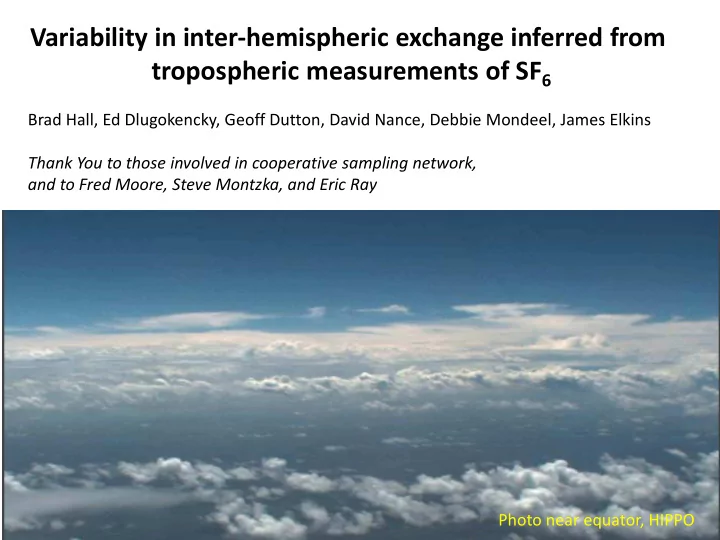

Variability in inter-hemispheric exchange inferred from tropospheric measurements of SF 6 Brad Hall, Ed Dlugokencky, Geoff Dutton, David Nance, Debbie Mondeel, James Elkins Thank You to those involved in cooperative sampling network, and to Fred Moore, Steve Montzka, and Eric Ray Photo near equator, HIPPO Photo courtesy of GMD photo library
Introduction Mechanisms of Inter-hemispheric Exchange Convective divergence in the upper troposphere • Seasonality in Hadley circulation (movement of the ITCZ) • Propagation of Rossby waves through tropical western ducts • Use global SF 6 observation to examine: Annual Cycle • Inter-Annual Variability • Trends •
January : Strong convection, mixing between hemispheres Mean Stream function - NCEP-NCAR reanalysis ( I M Dima and JM Wallace 2002) Courtesy of Fred Moore
April : Well-mixed hemispheres, limited mixing between hemispheres Mean Stream function - NCEP-NCAR reanalysis ( I M Dima and JM Wallace 2002) Courtesy of Fred Moore
Mean Inter-Hemispheric Exchange time Range: 1.0-1.5 yr (avg) Lintner et al., 2004 Waugh et al., 2014 Patra et al., 2009 Models predict bi-modal annual cycle. Slowest in spring/fall Fastest in summer/winter IAV: Mostly studied using models. - Link to ENSO - Slower during El Niño - Faster during La Niña Lintner et al (2004)
2-Box Model: Let A = E N /E S (assume 95% in N.H., A=19) We do not consider the loss term, or strat/trop exchange
Sampling Networks 12 sites (flask + in situ) (3 high alt.) 26 sites + 13 ship (flask) (all MBL)
S.H. Tropics Halocarbon Network: 1 site (SMO), flask + in situ CCGG Network: 2 sites (SMO, ASC, EIC) + 4 ships (-5°, -10°, -15°, -20°)
Methods: Surface data (marine boundary layer) • Smoothed, mass-weighed hemispheric averages (CCGG) (Thoning, Massarie) •
Annual Cycle Fewer sites More sites
Mean exchange time (2002-2015) = 1.18 yr Faster exchange in N.H. late summer. Faster exchange in N.H. winter solstice not always apparent
Inter-Annual Variability ? El Niño La Niña noaaß ∑/ esrl/psd/mei
Additional Uncertainties
Possible trend towards faster exchange Slope: -0.1 yr decade -1 (Not significant)
Assume E N /E S constant: 95% from N.H. Changes in N.H. source distribution: Shift towards lower latitudes
Summary The mean exchange time from 2002-2015 years is 1.18 yr We observe an annual cycle, with fastest exchange in Boreal late summer. Minimum expected in N.H. winter is not always pronounced. Some IAV correlated with ENSO: Slower during El Niño, faster during La Niña.
Recommend
More recommend